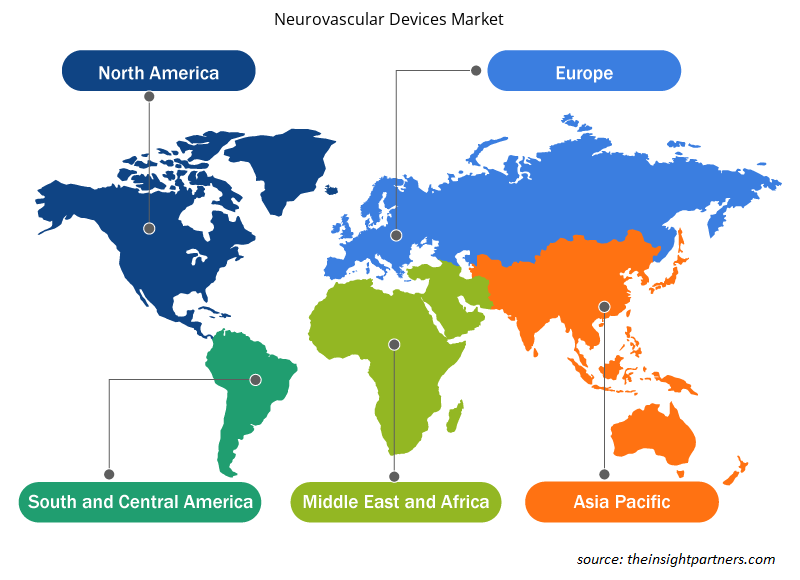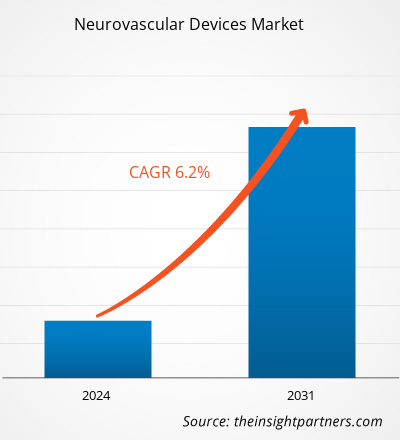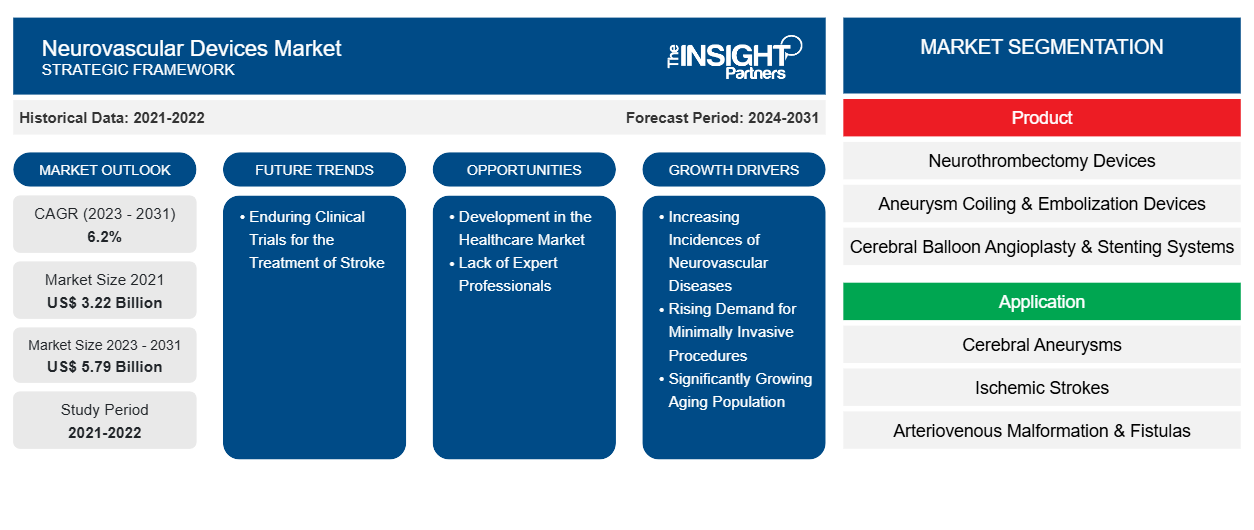El tamaño del mercado de dispositivos neurovasculares en 2021 se situó en 3.220 millones de dólares y se prevé que alcance los 5.790 millones de dólares en 2031, frente a los XX mil millones de dólares en 2023. Se espera que el mercado registre una CAGR del 6,2% entre 2023 y 2031. Es probable que el aumento de los ensayos clínicos en curso y la creciente prevalencia de los casos de accidente cerebrovascular en las economías desarrolladas y en desarrollo sigan siendo tendencias clave del mercado de dispositivos neurovasculares.neurovascular devices market size in 2021 stood at US$ 3.22 billion and is projected to reach US$ 5.79 billion by 2031 from US$ XX billion in 2023. The market is expected to register a CAGR of 6.2% in 2023–2031. Growing ongoing clinical trials and rising prevalence in the cases of stroke in developed as well as developing economies are likely to remain key neurovascular devices market trends.
Análisis del mercado de dispositivos neurovasculares Devices Market Analysis
Las técnicas avanzadas de diagnóstico por imagen y los procedimientos mínimamente invasivos han permitido a los profesionales sanitarios realizar procedimientos más precisos y menos invasivos, reduciendo en última instancia los riesgos asociados a los enfoques quirúrgicos tradicionales. La creciente prevalencia de enfermedades neurológicas es uno de los factores críticos que impulsan el crecimiento del mercado de dispositivos neurovasculares. Factores como el envejecimiento de la población y los cambios en el estilo de vida han provocado una mayor incidencia de enfermedades como los accidentes cerebrovasculares y los aneurismas cerebrales, lo que pone de relieve aún más la necesidad de intervenciones neurovasculares. Además, se ha producido un cambio sustancial hacia técnicas y dispositivos mínimamente invasivos, lo que ha reducido la invasividad de los procedimientos neurovasculares. Este cambio ha dado lugar a estancias hospitalarias más cortas, tiempos de recuperación más rápidos y menores costes sanitarios para el paciente, lo que ha hecho que estos procedimientos sean más accesibles y atractivos para los pacientes y los proveedores de atención sanitaria. Estos avances tecnológicos y médicos han contribuido colectivamente al impresionante crecimiento del mercado de dispositivos neurovasculares y han mejorado la atención y los resultados de los pacientes.
Descripción general del mercado de dispositivos neurovasculares
Los dispositivos neurovasculares tratan enfermedades de las arterias sanguíneas que suministran sangre rica en oxígeno al cerebro. En el caso de un aneurisma complejo, se utilizan dispositivos de trombectomía neurovascular para eliminar el coágulo que causó el accidente cerebrovascular. Muchos dispositivos endovasculares, como lazos, aspiradoras y dispositivos de extracción de coágulos sanguíneos, entran en esta categoría. El mercado se está expandiendo por muchas razones, como el rápido ritmo de innovación técnica en este sector. Los dispositivos neurovasculares incluyen sistemas de colocación de stents, dispositivos de embolización y dispositivos de neurotrombectomía utilizados para tratar enfermedades neurovasculares como los aneurismas cerebrales. Se espera que la creciente prevalencia de estas enfermedades en la población y el aumento de las iniciativas gubernamentales para crear conciencia sobre las opciones de tratamiento impulsen la demanda de productos para tratar estas enfermedades. devices treat diseases of the blood arteries that supply oxygen-rich blood to the brain. For a complex aneurysm, neurovascular thrombectomy devices are used to remove the clot that caused the stroke. Many endovascular devices, such as snares, vacuum cleaners, and blood clot extraction devices, fall into this category. The market is expanding for many reasons, such as the rapid pace of technical innovation in this sector. Neurovascular devices include stenting systems, embolization devices, and neurothrombectomy devices used to treat neurovascular diseases such as brain aneurysms. The increasing prevalence of these diseases in the population and increasing government initiatives to raise awareness of treatment options are expected to drive product demand to treat these diseases.
Personalice este informe según sus necesidades
Obtendrá personalización en cualquier informe, sin cargo, incluidas partes de este informe o análisis a nivel de país, paquete de datos de Excel, así como también grandes ofertas y descuentos para empresas emergentes y universidades.
-
Obtenga las principales tendencias clave del mercado de este informe.Esta muestra GRATUITA incluirá análisis de datos, desde tendencias del mercado hasta estimaciones y pronósticos.
Impulsores y oportunidades del mercado de dispositivos neurovasculares Devices Market Drivers and Opportunities
La creciente demanda de procedimientos mínimamente invasivos favorece al mercado
Las cirugías mínimamente invasivas están teniendo una gran aceptación debido a su atractivo estético y a los tiempos de recuperación más cortos, lo que podría agilizar aún más la expansión del mercado de los dispositivos neurovasculares. Los procedimientos quirúrgicos han introducido continuamente innovaciones y mejoras para hacerlos más seguros para los pacientes. La cirugía mínimamente invasiva se ha convertido en el estándar para los procedimientos quirúrgicos que tradicionalmente se realizaban mediante una técnica abierta. Estos procedimientos quirúrgicos incluyen la cirugía laparoscópica, la cirugía endoscópica y la cirugía robótica. La mayor demanda de procedimientos neuroquirúrgicos mínimamente invasivos, el creciente conocimiento de los neurocirujanos sobre los procedimientos mínimamente invasivos y el aumento de los estudios de investigación en el campo de la terapia neurovascular pueden brindar oportunidades lucrativas para los principales competidores en el próximo período. Se espera que estos escenarios favorezcan el panorama de la industria.neurovascular devices. Surgical procedures have continually introduced innovations and improvements to make them safer for patients. Minimally invasive surgery has become the standard for surgical procedures traditionally performed using an open technique. These surgical procedures include laparoscopic surgery, endoscopic surgery, and robotic surgery. The increased demand for minimally invasive neurosurgical procedures, the increasing knowledge of neurosurgeons about minimally invasive procedures, and the increase in research studies in the field of neurovascular therapy may provide lucrative opportunities for key competitors in the coming period. Such scenarios are expected to favor the industry landscape.
Estrategias de crecimiento crecientes: una oportunidad para el crecimiento del mercado de dispositivos neurovascularesNeurovascular Devices Market Growth
Se prevé que las estrategias de crecimiento orgánico crecientes, como las aprobaciones de productos por parte de las autoridades regulatorias para ampliar las carteras de productos de los actores clave, impulsen el crecimiento del mercado. Por ejemplo, Scientia Vascular, una empresa de dispositivos médicos con sede en EE. UU., anunció en mayo de 2021 que había recibido $50 millones en financiación de Vivo Capital, una empresa de inversión en atención médica, para desarrollar guías y microcatéteres para tratar los accidentes cerebrovasculares. Las tecnologías innovadoras seguirán ampliando la gama de herramientas neurovasculares disponibles para tratar varios tipos de aneurismas de forma más segura y eficiente. El tratamiento de los aneurismas evoluciona constantemente, con una tecnología sofisticada a la vanguardia de la innovación.Scientia Vascular, a US-based medical device company, announced in May 2021 that it had received $50 million in funding from Vivo Capital, a healthcare investment firm, to develop guidewires and microcatheters to treat stroke. Innovative technologies will continue to expand the range of neurovascular tools available to treat various types of aneurysms more safely and efficiently. Aneurysm management constantly evolves, with sophisticated technology at the forefront of innovation.
Análisis de segmentación del informe de mercado de dispositivos neurovasculares
Los segmentos clave que contribuyeron a la derivación del análisis del mercado de dispositivos neurovasculares son el producto, la aplicación y el usuario final.
- Según el producto, el mercado de dispositivos neurovasculares se divide en dispositivos de neurotrombectomía, dispositivos de embolización y espirales para aneurismas, sistemas de colocación de stents y angioplastia cerebral con balón y dispositivos de soporte. En 2023, el segmento de dispositivos de embolización y espirales para aneurismas tuvo la mayor participación del mercado, y se prevé que el mismo segmento registre la CAGR más alta durante el período de pronóstico. El segmento se clasifica además en espirales embólicas, espirales desmontables desnudas, espirales desmontables recubiertas, dispositivos de desviación de flujo y agentes embólicos líquidos.
- Por aplicación, el mercado está segmentado en aneurismas cerebrales, accidentes cerebrovasculares isquémicos, malformaciones arteriovenosas y fístulas, entre otros. En 2023, el segmento de accidentes cerebrovasculares isquémicos tuvo la mayor participación del mercado, y se prevé que el mismo segmento registre la CAGR más alta durante 2023-2031.
- En términos de usuario final, el mercado está segmentado en hospitales, centros quirúrgicos ambulatorios y clínicas especializadas. En 2023, el segmento de hospitales tuvo la mayor participación del mercado y se estima que el mismo segmento registrará la CAGR más alta durante el período de pronóstico. Se espera que el segmento de hospitales crezca al ritmo más rápido durante el próximo año debido a la disponibilidad de mejores instalaciones de atención médica, así como a las políticas de reembolso de los organismos gubernamentales.
Análisis de la cuota de mercado de dispositivos neurovasculares por geografía
El alcance geográfico del informe de mercado de dispositivos neurovasculares se divide principalmente en cinco regiones: América del Norte, Asia Pacífico, Europa, Medio Oriente y África, y América del Sur/América del Sur y Central.
América del Norte ha dominado el mercado de dispositivos neurovasculares. El crecimiento del mercado en América del Norte se atribuye a la creciente prevalencia de diversas enfermedades neurológicas y a las mayores tasas de diagnóstico y tratamiento. Además, el aumento del gasto sanitario para apoyar la atención neurológica en la región y el reembolso adecuado para diversas enfermedades neurológicas fomentarán la introducción de opciones de tratamiento novedosas y avanzadas. Por ejemplo, las aseguradoras de salud privadas y públicas como Medicare, Medicaid y otras ofrecen políticas de reembolso favorables para productos neurovasculares, incluidas todas las bobinas embólicas y de fluidos. Además, los avances tecnológicos y el aumento de las actividades de investigación y desarrollo que conducen al lanzamiento y aprobación de productos, así como las asociaciones y adquisiciones por parte de actores clave, contribuyen al crecimiento del mercado. Por ejemplo, en julio de 2022, Rapid Medical, un desarrollador de dispositivos neurovasculares avanzados, recibió la autorización 510(k) de la FDA para TIGERTRIEVER para el tratamiento de oclusiones de grandes vasos en la Reunión Anual 2022 de la Sociedad de Cirugía Neurointervencionista (SNIS) en Toronto. El dispositivo es uno de los dispositivos de revascularización más pequeños que se utilizan para eliminar trombos de los delicados vasos sanguíneos del cerebro durante un accidente cerebrovascular isquémico. Se espera que estos avances impulsen el crecimiento del mercado en la región durante el período de pronóstico, ya que ofrecen un enfoque menos traumático que los dispositivos existentes. Se prevé que Asia Pacífico crezca con la CAGR más alta en los próximos años.
Noticias y desarrollos recientes del mercado de dispositivos neurovasculares
El mercado de dispositivos neurovasculares se evalúa mediante la recopilación de datos cualitativos y cuantitativos posteriores a la investigación primaria y secundaria, que incluye publicaciones corporativas importantes, datos de asociaciones y bases de datos. A continuación, se incluye una lista de los avances en el mercado de dispositivos neurovasculares:
- Medtronic recibió la marca CE para el sistema TAVI Evolut FX para el tratamiento de la estenosis aórtica grave. El sistema de implantación de válvula aórtica transcatéter (TAVI), el sistema TAVI de última generación de la plataforma CoreValveTM/Evolut TAVI. (Medtronic, comunicado de prensa, 2023)
- Stryker anunció que completó la adquisición de Cerus Endovascular Ltd., una empresa privada de dispositivos médicos en etapa comercial dedicada al diseño y desarrollo de dispositivos neurointervencionistas para el tratamiento de aneurismas intracraneales. Los productos con marcado CE de Cerus Endovascular, el sistema neurovascular Contour y el desviador de flujo asistido por bobina Neqstent, ampliarán la cartera actual de soluciones de tratamiento de aneurismas de Stryker. (Stryker, Noticias, 2023)
- ASAHI INTECC CO., LTD. anunció que ha firmado un contrato con Sensome SAS (“Sensome”), una empresa francesa de dispositivos médicos, para desarrollar y fabricar una guía inteligente para accidentes cerebrovasculares de última generación. (ASAHI INTECC CO., LTD., Noticias, 2023)
- Stryker inauguró un laboratorio de investigación y desarrollo neurovascular de última generación con tecnología avanzada para acelerar la innovación en el tratamiento de accidentes cerebrovasculares en Asia Pacífico. (Stryker, News, 2022)
- Genesis MedTech Group llegó a un consenso para adquirir la totalidad de Hua Medtech como parte de sus planes para establecer una franquicia neurovascular especializada, que entró en cooperación estratégica con Penumbra, Inc., para la venta y producción nacional de productos con la tecnología de Penumbra para el mercado chino. (Genesis Medtech, Noticias, 2021)
Perspectivas regionales del mercado de dispositivos neurovasculares
Los analistas de Insight Partners explicaron en detalle las tendencias y los factores regionales que influyen en el mercado de dispositivos neurovasculares durante el período de pronóstico. Esta sección también analiza los segmentos y la geografía del mercado de dispositivos neurovasculares en América del Norte, Europa, Asia Pacífico, Oriente Medio y África, y América del Sur y Central.

- Obtenga datos regionales específicos para el mercado de dispositivos neurovasculares
Alcance del informe de mercado de dispositivos neurovasculares
| Atributo del informe | Detalles |
|---|---|
| Tamaño del mercado en 2021 | US$ 3.22 mil millones |
| Tamaño del mercado en 2031 | 5.79 mil millones de dólares estadounidenses |
| CAGR global (2023 - 2031) | 6,2% |
| Datos históricos | 2021-2022 |
| Período de pronóstico | 2024-2031 |
| Segmentos cubiertos |
Por producto
|
| Regiones y países cubiertos |
América del norte
|
| Líderes del mercado y perfiles de empresas clave |
|
Densidad de actores del mercado: comprensión de su impacto en la dinámica empresarial
El mercado de dispositivos neurovasculares está creciendo rápidamente, impulsado por la creciente demanda de los usuarios finales debido a factores como la evolución de las preferencias de los consumidores, los avances tecnológicos y una mayor conciencia de los beneficios del producto. A medida que aumenta la demanda, las empresas amplían sus ofertas, innovan para satisfacer las necesidades de los consumidores y aprovechan las tendencias emergentes, lo que impulsa aún más el crecimiento del mercado.
La densidad de actores del mercado se refiere a la distribución de las empresas o firmas que operan dentro de un mercado o industria en particular. Indica cuántos competidores (actores del mercado) están presentes en un espacio de mercado determinado en relación con su tamaño o valor total de mercado.
Las principales empresas que operan en el mercado de dispositivos neurovasculares son:
- Medtronic plc,
- Corporación Stryker.,
- Servicios Johnson & Johnson, Inc.,
- Acandis GmbH & Co. KG.,
- Corporación científica MicroPort,
- Corporación Terumo,
Descargo de responsabilidad : Las empresas enumeradas anteriormente no están clasificadas en ningún orden particular.

- Obtenga una descripción general de los principales actores clave del mercado de dispositivos neurovasculares
Informe sobre el mercado de dispositivos neurovasculares: cobertura y resultados
El informe “Tamaño y pronóstico del mercado de dispositivos neurovasculares (2021-2031)” proporciona un análisis detallado del mercado que cubre las siguientes áreas:
- Tamaño del mercado y pronóstico a nivel global, regional y nacional para todos los segmentos clave del mercado cubiertos bajo el alcance
- Dinámica del mercado, como impulsores, restricciones y oportunidades clave
- Principales tendencias futuras
- Análisis detallado de las cinco fuerzas de Porter y PEST y FODA
- Análisis del mercado global y regional que cubre las tendencias clave del mercado, los principales actores, las regulaciones y los desarrollos recientes del mercado.
- Análisis del panorama de la industria y de la competencia que abarca la concentración del mercado, el análisis de mapas de calor, los actores destacados y los desarrollos recientes
- Perfiles detallados de empresas
- Análisis histórico (2 años), año base, pronóstico (7 años) con CAGR
- Análisis PEST y FODA
- Tamaño del mercado, valor/volumen: global, regional y nacional
- Industria y panorama competitivo
- Conjunto de datos de Excel
Informes recientes
Testimonios
Razón para comprar
- Toma de decisiones informada
- Comprensión de la dinámica del mercado
- Análisis competitivo
- Información sobre clientes
- Pronósticos del mercado
- Mitigación de riesgos
- Planificación estratégica
- Justificación de la inversión
- Identificación de mercados emergentes
- Mejora de las estrategias de marketing
- Impulso de la eficiencia operativa
- Alineación con las tendencias regulatorias























 Obtenga una muestra gratuita para - Mercado de dispositivos neurovasculares
Obtenga una muestra gratuita para - Mercado de dispositivos neurovasculares